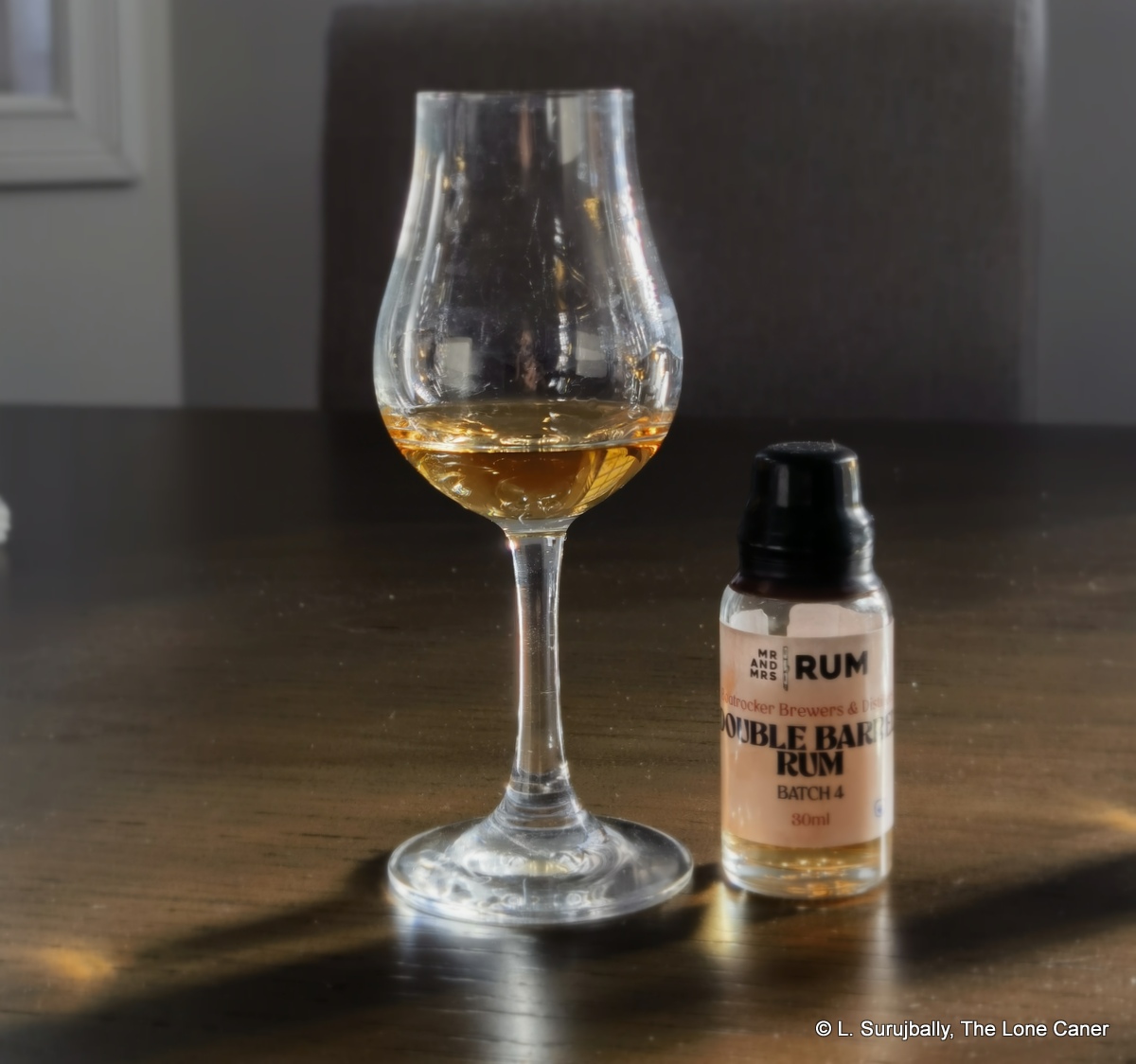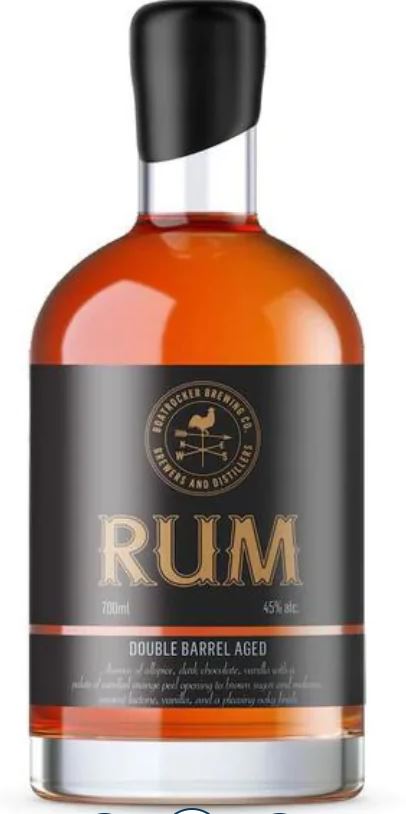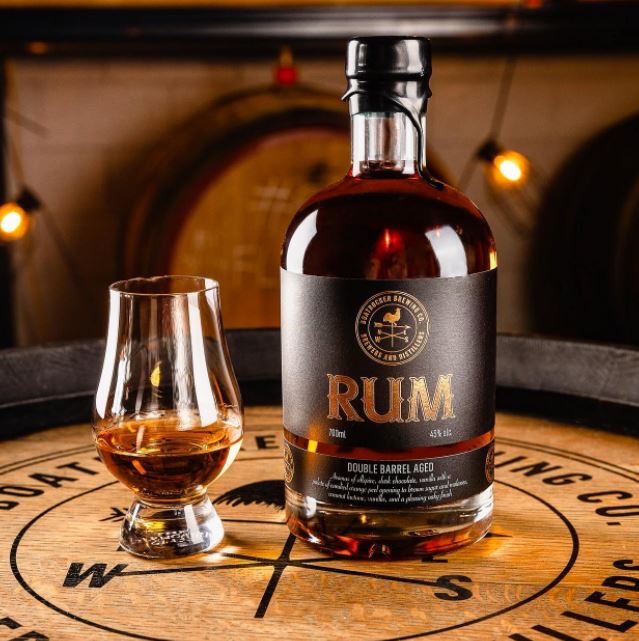 We met this distillery before, last time we had an advent calendar: back then they were presenting Batch #3 of their double barrel rum, and now here we have the next iteration, the Batch #4.
We met this distillery before, last time we had an advent calendar: back then they were presenting Batch #3 of their double barrel rum, and now here we have the next iteration, the Batch #4.
You can read a more extended company bio below this review, so let’s skip right to the rum itself, for which the production process is the same as before. A primary ferment uses a yeast originally from Jamaica; a dunder/muck pit (also not mentioned on the site) provides cultured bacteria, and wild yeast is from the local area, all which is continually evolving as they add fresh dunder at the end of each rum run to boost the ester count. How long the fermentation goes on for is unknown, but once this process is complete, the rum distillation is done using the their 450 litre hybrid pot still (with two ten-plate columns) and engaging just the first column and five plates – the juice comes off the still at around 58% ABV, and set to age for about two years in first-use bourbon barrels imported from the USA, with a further year in high-char (#3) American oak barrels. Bottling is done after dilution to 45% ABV, and there you have it. New rum. Made just like the old rum.
Let’s start with the nose. Some of the same richness of aroma attended the first sniff, though here, instead of leading with the wine profile, what I got was more of a spice forward smell: vanilla, cinnamon, cardamom, a trace of nutmeg. It was also slightly more woody, had some sawdust notes, and gradually showed off warm pastries dusted with icing sugar fresh out of the oven. Cherries in sweet syrup, black grapes, raisins, bitter chocolate, and even a touch of ice cream, finished things off, so on that score, it compared well with B#3..except for one thing: somehow, it was not as richly pungent, or as intense as I recalled.
The taste there is something of the same issue I had had before: it was thinner and, in fact, here it almost seemed snide, a trifle bitchy. There were fruits, vanilla, chocolate oranges, some crushed almonds, molasses and touch of citrus. But it was all something of a disorganised mishmash – the nose really had more elegance than what the palate was demonstrating. After trying it a few times I noticed cashews, honey and bitter chocolate (again), and the spiced pungency of a German glühwein on a particularly cold winter day in the Weihnachtsmarkt. And lastly, something that would make Mrs. Caner swoon if she sensed it, the aromatic hint of a brand new soft leather purse (the expensive kind). The finish was short and none too demonstrative, being content to repeat these notes – rather fewer of them, in fact – and letting the whole thing expire without fuss or memory.
Surprisingly, I was less impressed this go-around than I had been with the previous iteration, although since my other sample remains in Germany I could not compare them directly (but I have extensive files, so…). Very much like before, I enjoyed the nose the most, with a gradually decreasing appreciation for the stages after that. Part of it is simply the integration, the way the components all came together…or didn’t. It seemed there were a lot of interesting pieces on display – fruits, woody tannins, spices, sweet, a touch of sour – but somehow they had a failure to communicate. With Batch #3 I suggested it was something of a work in progress with room for improvement to realise its potential. The jury remains out on that, especially with respect to this one.
(#1070)(80/100) ⭐⭐⭐
Company notes (from Review #905)
The distillery and brewery called Boatrocker (with what I am sure is representative of a tongue-in-cheek sense of humour shared by many Aussies) is another small family-run outfit located in Melbourne, a mere 50km or so north of JimmyRum. It was officially founded in 2009, and like many other such small enterprises I’ve written about, their genesis is far older: in this case, in the 1980s, when the (then teenaged) founder, Matt Houghton, was enthused by the Michael Jackson (no, not that Michael Jackson) show “The Beer Hunter” – this led to a lifelong love of beer, homebrewing, studies of the subject in University, and even gypsy brewing after graduation, which he and his wife Andrea did while saving pennies for a “real” brewery. In 2012 they acquired property, plant and equipment (as the bean counters like to say), and established their first barrel room and cellar door, all to do with beer.
They soon gained an enthusiastic following and a good reputation for their beers, but where’s the rum, you ask. Well, that’s where things get a little murky and several sources have to be consulted over and above the company webpage. In short, in 2017 Boatrocker merged with a Western Australian gin-and-vodka distillery called Hippocampus — the investing owner of that distillery had taken a 33% share in Boatrocker in 2015 — uprooted that company’s hybrid still “Kylie” and moved lock stock and barrels to Melbourne. This is what is making all the distilled spirits in Boatrocker now, though I get the impression that a separate team is involved. They produce gin (several varieties, of course), whiskey, vodka and two rums (one is spiced). Oddly, there’s no unaged white in the portfolio, but perhaps they made enough money off of existing spirits, so that the need to have a white cane spirit was not seen to be as important. On the other hand, rum may not seem to be the main attraction of the company so perhaps that explains it.
Other notes
- From the 2023 Australian Advent Calendar, Day 3

